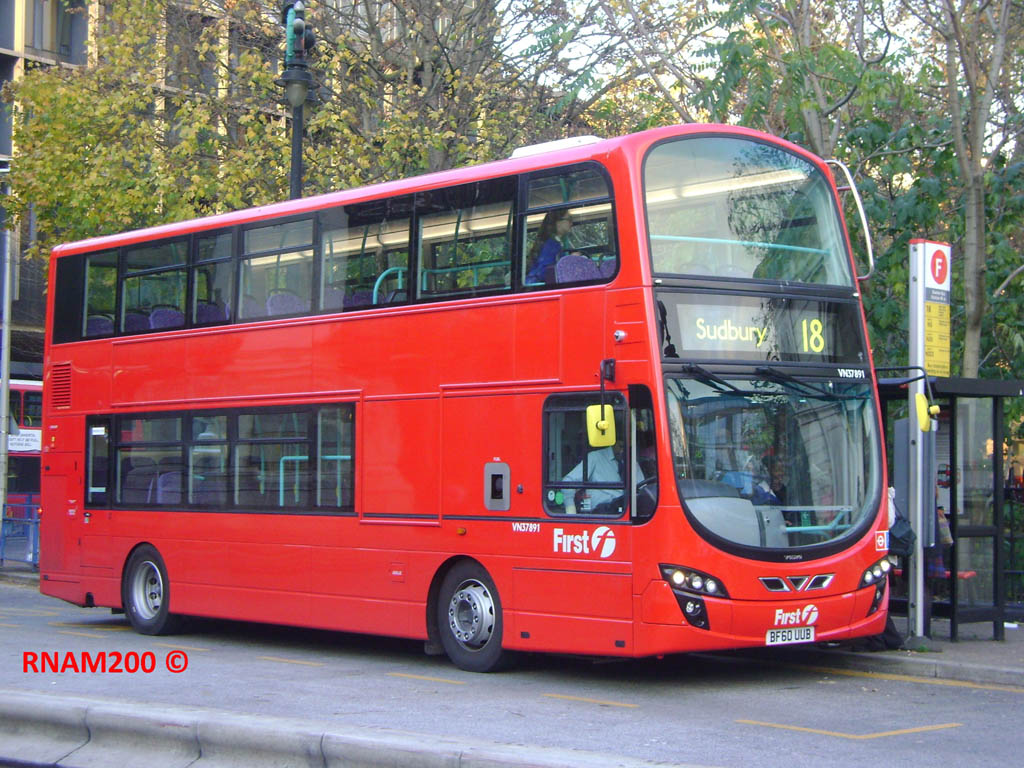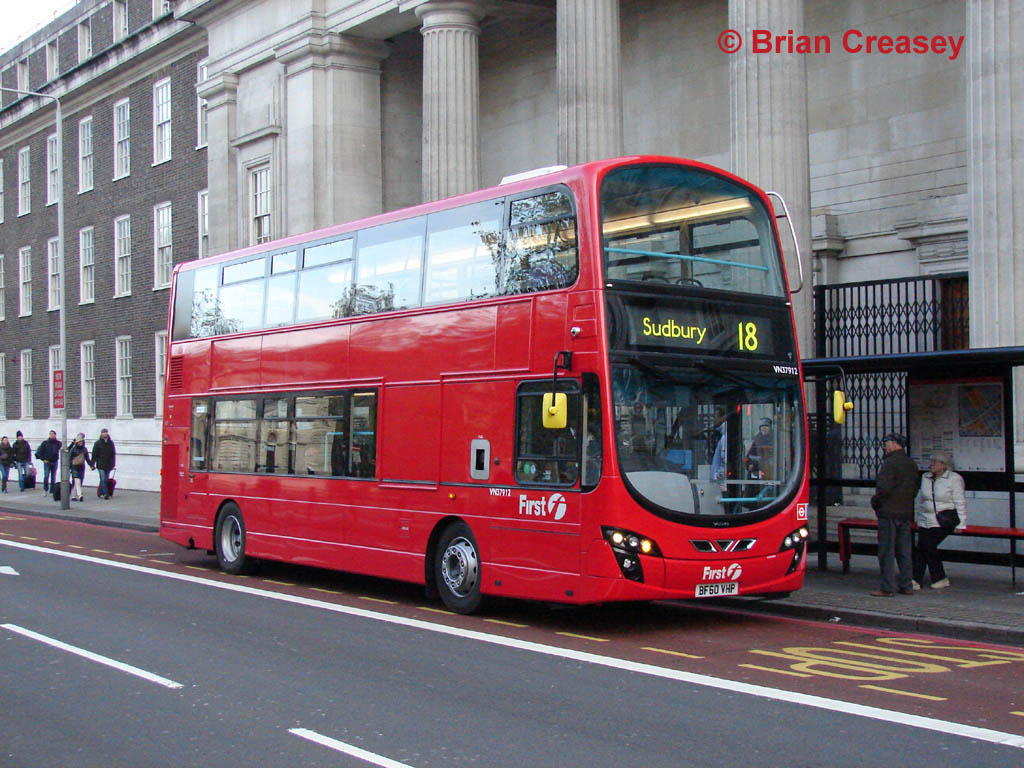 | Photo © RNAM200 (Robert Mighton). |
Home | Bus routes | Operational details | Service changes | Operators & Garages | Photo gallery
Route 18 was the first London route to undergo a straight conversion from double deckers to articulated single deckers – a surprising choice, given that the route already had low floor vehicles in place. But now, in line with the new Mayor of London's policy, double deck buses have returned, with a 50% increase in peak vehicle requirement and a frequency increase round the week to compensate for lower capacity of each bus. This time VN class Wright Gemini 2 bodied Volvo B9TLs are in use, and the class is represented by VN37891 (BF60 UUB) at Euston station on 15 November 2010, the first weekday of the new double deck timetable.
 | Photo © RNAM200 (Robert Mighton). |
Just round the corner in Euston Road on the same day, VN37912 (BF60 VHP) starts to make headway on the haul to Sudbury, which will take it through some of the grimmer parts of West London. There were some concerns about peak crowding leading to proposals for a couple of extra "crowd-buster" trips, but these have not come about yet, perhaps indicating that teething problems have been resolved. There certainly does not seem to be a shortage of capacity on this part of the route!
 | Photo © Brian Creasey. |
Prior to its artic conversion, the 18 had been operated from Westbourne Park garage using TN class Tridents. However, there was not enough space for the larger buses (especially as route 10 was already temporarily outstationed) so a new base was obtained near Willesden Junction station; this was almost coded J, but in the end the more logical code WJ was adopted! This particular conversion went with more than the usual number of teething troubles, no doubt partly because of the new garage. There were also problems with overcrowding, because a substantial cut in frequency was implemented at the same time – this caused some controversy as, unlike the previous 436 and 453 artic introductions, most passengers on the 18 have no alternative routes to choose from. A frequency increase was subsequently implemented to deal with the issues.
Having obtained the extra garage space, the 18 has remained at the new garage following conversion to double deck – there was no reason to move it back, and indeed Westbourne Park garage is having to be reduced in size as part of its land is taken over for the Crossrail project.
Despite cutbacks, the 18 is still quite a long bus route by today's standards, running from the central terminus at Euston out to Sudbury. However, the service structure has been very much simplified. My first record, as ever, is from 1934, when there were four routes, 18, 18A, 18B and 18C. The 18, 18A, plus 18B on weekdays, started from London Bridge station, running via Southwark Bridge, St. Paul’s and Grays Inn Road to King’s Cross. From there the 18 and 18B ran daily, the 18A on Mondays to Saturdays and the 18C on Sundays, via Paddington and the Harrow Road to Harlesden, where the 18A diverted off to Park Royal. The other three routes continued to Stonebridge Park, where the 18B peeled off via the North Circular Road to ‘Brent’ (Cross, as we would call it today). The 18C daily service started from Wembley (Empire Pool), near Wembley Park station, so that just the 18 and 18C served Wembley and Sudbury. There, the 18C headed south to Greenford and Hanwell, while the 18 headed north to Harrow and Harrow Weald.
There were very many changes to the routes, too many to list in detail here, but interestingly the 18 was withdrawn between central London and Harlesden except on Saturday afternoons and Sundays, times at which the 18A no longer ran. It should therefore be noted that at this time there was no through service from Wembley to central London, except that provided on Saturday afternoons and Sundays by the 18 and 18C, since the 18A and 18B did not serve Wembley.
The 18A was very much the main service, running every 4 minutes, but was withdrawn without replacement after operation on 17 October 1939, new trolleybus 662 (Paddington Green to Sudbury) having taken away a fair proportion of the passengers. The 18C Sunday extension into the centre was also withdrawn, leaving the route with very little in common with its parent. Similarly the 18 was cropped back to Wembley (Empire Pool) on Mondays to Saturdays, but on the other hand was diverted at Wealdstone to serve Canons Park and Edgware, with a peak hours and Sundays extension to provide the only ‘normal’ bus service to the famous Aldenham Works in Elstree. The 18C was sensibly renumbered 92 on 14 June 1944, with a 92A variant running to Wembley Trading Estate at certain times of the week.
These arrangements lasted for some years, but trolleybus replacement in the 1960s saw the 18 extended back to Paddington Green replacing the 662. The 18B was also taken off, and in consequence the 18 continued except on Monday to Saturday evenings to London Bridge. But a surprise was the re-appearance at peak hours of the long-lost 18A, running between Acton and Paddington Green via a slightly different route. This was extended to Baker Street in 1978, but did not survive the September 1982 bus cuts.
In 1970, the 18 was cut back to run only as far out as Sudbury, with new route 182 covering the section between Wembley and Harrow Weald (and on to Watford), and the 186 the section between Harrow and Edgware, both routes later being extended to the new shopping centre at Brent Cross. In 1985 the 18 was also cut back at the other end to King’s Cross, apart from a peak hours service as far as Farringdon Street, still with no evening or Sunday service east of Baker Street. The section between King’s Cross and London Bridge was covered by new route 17 instead, though that route no longer serves Southwark Bridge.
The King’s Cross to Farringdon Street extension was also lost in 1991, and all evening, Saturday and Sunday service east of Baker Street was removed in 1992. As far as I can remember the service structure was then to have a 6 minute service (12 evenings and Sundays) as far as Baker Street, with alternate buses extended during the day on Mondays to Fridays to King’s Cross. London Transport’s drive for standardisation saw an end to this potentially confusing practice, with a compromise terminal of Euston introduced in the mid 1990s. No further changes have been made since then.
Navigation
| Previous | Next | |
| Chronologically | 103 | B11 |
| Numerically | 16 | 23 |
Photo Gallery | Bus route list | Operational details | Service changes | Operators & Garages